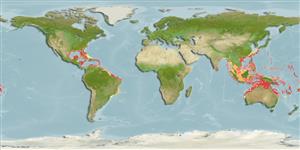Common names from other countries
Classification / Names / Names
Populärnamn | synonymer | Catalog of Fishes (gen., sp.) | ITIS | CoL | WoRMS
Environment: milieu / climate zone / depth range / distribution range
Ekologi
; brackvatten; djupintervall 1 - 91 m (Ref. 108813). Tropical
Indo-Pacific and Western Atlantic: Caribbean wide.
Length at first maturity / Size / Vikt / Age
Maturity: Lm ? range ? - ? cm Max length : 60.0 cm TL hane/ej könsbestämd; (Ref. 415)
Sprawling ramose branches, with spiky surface up to 60 cm long; 1 - 5 cm wide. Black with green patches internally and externally. Oscula 0.1 - 0.3 cm in diameter, on side of branches (Ref. 415). Smaller specimens grows as lobes, runners, massive or encrusting. Surface: covered with conules; mostly or entirely smooth for small specimens. Sometimes greenish-yellow. Tough consistency; resilient and barely compressible. Exudate is dark purplish when squeezed. Oscules are scattered or in a row, slightly raised on small lobes and surrounded by a thin collar (Ref. 85482).
Life cycle and mating behavior
Könsmognad | Reproduktion | Lek | Ägg | Fecundity | Larver
Members of the class Demospongiae are hermaphroditic. Life cycle: The zygote develops into parenchymella larva (free-swimming) before settling down on a substrate where it grows into a young sponge.
Collin, R., M.C. Díaz, J. Norenburg, R.M. Rocha, J.A. Sánchez, M. Schulze, A. Schwartz and A. Valdés. 2005. (Ref. 415)
IUCN Red List Status (Ref. 130435: Version 2024-1)
CITES status (Ref. 108899)
Not Evaluated
Not Evaluated
Threat to humans
Harmless
Human uses
| FishSource |
Verktyg
Ytterligare information
Age/SizeTillväxtLength-weightLength-lengthMorfologiLarverAbundans
Internet-källor
Estimates based on models
Preferred temperature
(Ref.
115969): 23.9 - 28.9, mean 27.5 (based on 1216 cells).
Vulnerability
Moderate vulnerability (44 of 100).
Price category
Unknown.
